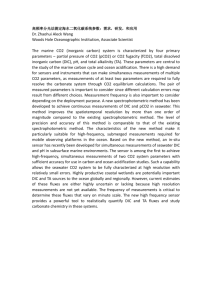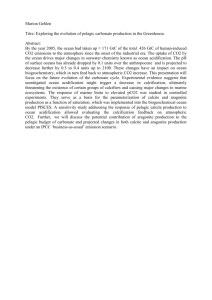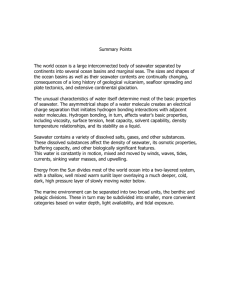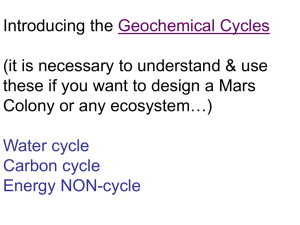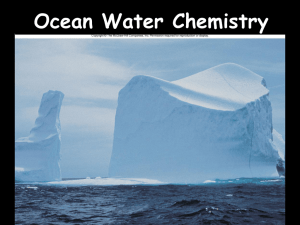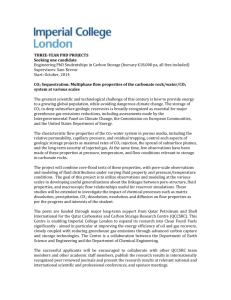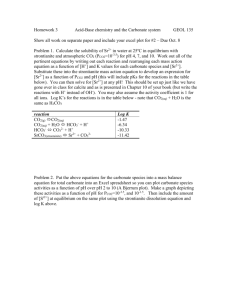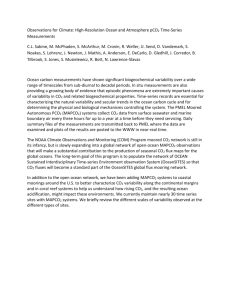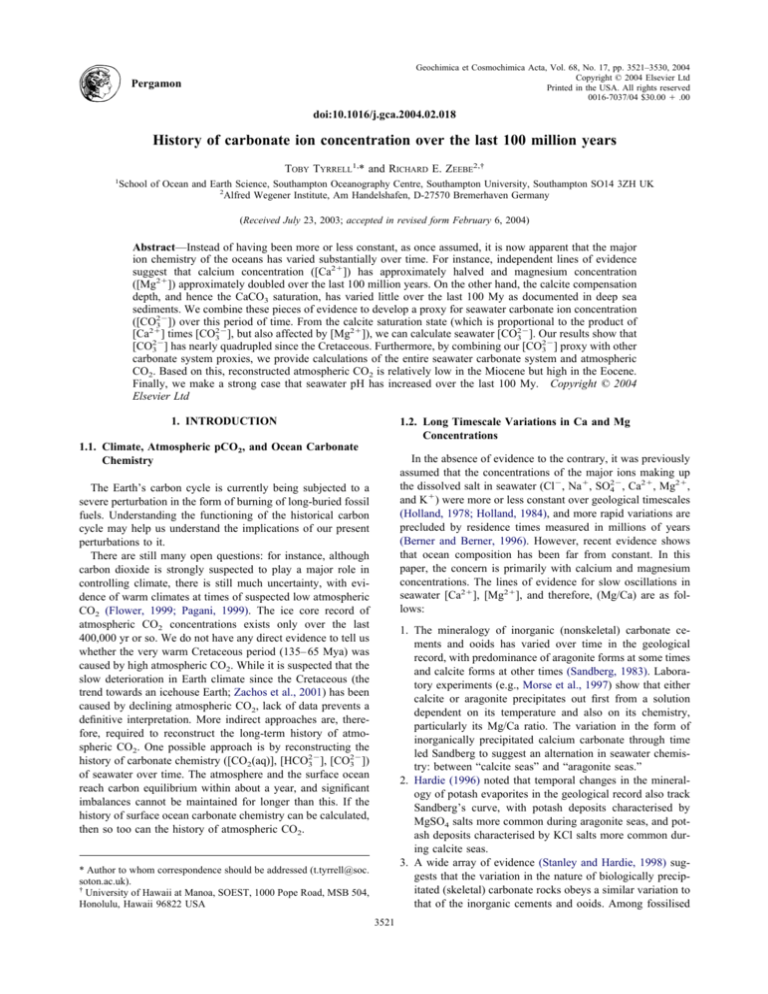
Geochimica et Cosmochimica Acta, Vol. 68, No. 17, pp. 3521–3530, 2004
Copyright © 2004 Elsevier Ltd
Printed in the USA. All rights reserved
0016-7037/04 $30.00 ⫹ .00
Pergamon
doi:10.1016/j.gca.2004.02.018
History of carbonate ion concentration over the last 100 million years
TOBY TYRRELL1,* and RICHARD E. ZEEBE2,†
1
School of Ocean and Earth Science, Southampton Oceanography Centre, Southampton University, Southampton SO14 3ZH UK
2
Alfred Wegener Institute, Am Handelshafen, D-27570 Bremerhaven Germany
(Received July 23, 2003; accepted in revised form February 6, 2004)
Abstract—Instead of having been more or less constant, as once assumed, it is now apparent that the major
ion chemistry of the oceans has varied substantially over time. For instance, independent lines of evidence
suggest that calcium concentration ([Ca2⫹]) has approximately halved and magnesium concentration
([Mg2⫹]) approximately doubled over the last 100 million years. On the other hand, the calcite compensation
depth, and hence the CaCO3 saturation, has varied little over the last 100 My as documented in deep sea
sediments. We combine these pieces of evidence to develop a proxy for seawater carbonate ion concentration
([CO2⫺
3 ]) over this period of time. From the calcite saturation state (which is proportional to the product of
2⫹
[Ca2⫹] times [CO2⫺
]), we can calculate seawater [CO2⫺
3 ], but also affected by [Mg
3 ]. Our results show that
[CO2⫺
]
has
nearly
quadrupled
since
the
Cretaceous.
Furthermore, by combining our [CO2⫺
3
3 ] proxy with other
carbonate system proxies, we provide calculations of the entire seawater carbonate system and atmospheric
CO2. Based on this, reconstructed atmospheric CO2 is relatively low in the Miocene but high in the Eocene.
Finally, we make a strong case that seawater pH has increased over the last 100 My. Copyright © 2004
Elsevier Ltd
1. INTRODUCTION
1.2. Long Timescale Variations in Ca and Mg
Concentrations
1.1. Climate, Atmospheric pCO2, and Ocean Carbonate
Chemistry
In the absence of evidence to the contrary, it was previously
assumed that the concentrations of the major ions making up
2⫹
the dissolved salt in seawater (Cl⫺, Na⫹, SO2⫺
, Mg2⫹,
4 , Ca
⫹
and K ) were more or less constant over geological timescales
(Holland, 1978; Holland, 1984), and more rapid variations are
precluded by residence times measured in millions of years
(Berner and Berner, 1996). However, recent evidence shows
that ocean composition has been far from constant. In this
paper, the concern is primarily with calcium and magnesium
concentrations. The lines of evidence for slow oscillations in
seawater [Ca2⫹], [Mg2⫹], and therefore, (Mg/Ca) are as follows:
The Earth’s carbon cycle is currently being subjected to a
severe perturbation in the form of burning of long-buried fossil
fuels. Understanding the functioning of the historical carbon
cycle may help us understand the implications of our present
perturbations to it.
There are still many open questions: for instance, although
carbon dioxide is strongly suspected to play a major role in
controlling climate, there is still much uncertainty, with evidence of warm climates at times of suspected low atmospheric
CO2 (Flower, 1999; Pagani, 1999). The ice core record of
atmospheric CO2 concentrations exists only over the last
400,000 yr or so. We do not have any direct evidence to tell us
whether the very warm Cretaceous period (135– 65 Mya) was
caused by high atmospheric CO2. While it is suspected that the
slow deterioration in Earth climate since the Cretaceous (the
trend towards an icehouse Earth; Zachos et al., 2001) has been
caused by declining atmospheric CO2, lack of data prevents a
definitive interpretation. More indirect approaches are, therefore, required to reconstruct the long-term history of atmospheric CO2. One possible approach is by reconstructing the
2⫺
history of carbonate chemistry ([CO2(aq)], [HCO2⫺
3 ], [CO3 ])
of seawater over time. The atmosphere and the surface ocean
reach carbon equilibrium within about a year, and significant
imbalances cannot be maintained for longer than this. If the
history of surface ocean carbonate chemistry can be calculated,
then so too can the history of atmospheric CO2.
1. The mineralogy of inorganic (nonskeletal) carbonate cements and ooids has varied over time in the geological
record, with predominance of aragonite forms at some times
and calcite forms at other times (Sandberg, 1983). Laboratory experiments (e.g., Morse et al., 1997) show that either
calcite or aragonite precipitates out first from a solution
dependent on its temperature and also on its chemistry,
particularly its Mg/Ca ratio. The variation in the form of
inorganically precipitated calcium carbonate through time
led Sandberg to suggest an alternation in seawater chemistry: between “calcite seas” and “aragonite seas.”
2. Hardie (1996) noted that temporal changes in the mineralogy of potash evaporites in the geological record also track
Sandberg’s curve, with potash deposits characterised by
MgSO4 salts more common during aragonite seas, and potash deposits characterised by KCl salts more common during calcite seas.
3. A wide array of evidence (Stanley and Hardie, 1998) suggests that the variation in the nature of biologically precipitated (skeletal) carbonate rocks obeys a similar variation to
that of the inorganic cements and ooids. Among fossilised
* Author to whom correspondence should be addressed (t.tyrrell@soc.
soton.ac.uk).
†
University of Hawaii at Manoa, SOEST, 1000 Pope Road, MSB 504,
Honolulu, Hawaii 96822 USA
3521
3522
T. Tyrrell and R. E. Zeebe
‘hypercalcifying’ organisms (corals, sponges, coralline algae, etc.), aragonitic species were more common during
Sandberg’s aragonite seas, whereas calcitic species were
more common during Sandberg’s calcite seas.
4. These indirect suggestions of Mg/Ca oscillations have recently been reinforced by more direct measurements, from
fluid inclusions in marine halites (e.g., Lowenstein et al.,
2001; Horita et al., 2002). These fluid inclusions (microscopic globules trapped in salt crystals as they form in
evaporating seawater) contain evidence of the ocean chemistry at that time. The partially evaporated nature of the fluid
inclusions excludes a completely straightforward reconstruction of past seawater composition, but much information can still be derived. An immediate point of interest is
that the chemistry of the fluid inclusions is often very
different from that of any point along the evaporation pathway of modern-day seawater, implying very different preevaporation chemistries. It is not possible to evaporate modern day seawater to produce a brine resembling many of the
Phanerozoic fluid inclusions. Similarities in chemical composition of fluid inclusions in rocks of similar age, but
deposited in different parts of the world, argue for control by
swings in global seawater composition rather than by local
or regional processes (Lowenstein et al., 2001; Horita et al.,
2002). The concentrations of ions unlikely to precipitate out
until very late in the evaporation sequence, and with very
long residence times in seawater (e.g., Br⫺, ⬃100 My;
(Holland, 1978)), can give an idea of the “degree of evaporation” of each inclusion. Two of the earliest salts to
precipitate out as seawater becomes progressively more
concentrated are calcium carbonate (CaCO3), then gypsum/
anhydrite (CaSO4); the presence of residual [Ca2⫹] but no
[SO2⫺
4 ] in samples from some times, in contrast to residual
2⫹
[SO2⫺
] at other times, points to variations in
4 ] but no [Ca
the initial [Ca2⫹] and [SO2⫺
4 ]. Through the use of these and
other techniques and assumptions, best-guess [Ca2⫹] and
[Mg2⫹] concentrations (Zimmermann, 2000; Horita et al.,
2002) and seawater (Mg/Ca) (Lowenstein et al., 2001;
Horita et al., 2002) have been calculated back through time
from the fluid inclusions, and they agree well with Sandberg’s calcite and aragonite seas.
5. Another recent record for past seawater (Mg/Ca) has been
obtained from the (Mg/Ca) of echinoderm skeletons (Dickson, 2002). Echinoderms incorporate Mg and Ca into their
shells in a variable ratio linked to that of the seawater they
grow in. Their fossilized skeletons have been analysed and
the inferred history of Mg/Ca broadly supports that from
fluid inclusions (Dickson, 2002).
6. Stanley et al. (2002) found in laboratory culture experiments
that, like echinoderms, the (Mg/Ca) of the calcite skeletons
of coralline algae reflects that of the seawater medium they
grow in. The predominance of low-Mg calcite fossils during
calcite seas (low seawater Mg/Ca), and of high-Mg calcite
fossils during aragonite seas, (high seawater Mg/Ca) (Stanley and Hardie, 1998) therefore, also supports variable seawater (Mg/Ca) through time.
(1996) and Holland and Zimmermann (1998) for counterarguments), or alternatively, a change in the mode of calcium
carbonate deposition (Volk, 1989). The timing of the beginning
of the most recent seawater calcium decline corresponds approximately with the laying down of the first massive coccolith
chalks in the Late Cretaceous (99 – 65 Mya) and the beginning
of significant calcium carbonate flux to deep ocean sediments
following the rise to abundance of the main planktonic calcifiers, coccolithophores and foraminifera (Volk, 1989; Hay,
1999). Most shelf sediments are eventually uplifted and the
calcium within them then returned by erosion to rivers and then
back to the sea; most deep-sea sediments, in contrast, are
eventually subducted at continental margins, taking calcium
down into the mantle. Increasing Ca2⫹ loss from the oceans has
been accompanied by decreasing Mg2⫹ loss, probably because
dolomitisation (formation of CaMg(CO3)2 rocks) is thought to
have only taken place in shallow environments (Holland and
Zimmerman, 2000).
Regardless of the cause, the point of interest for this paper is
that, taken as a whole, “these studies develop an argument of
unprecedented strength for a chemically dynamic ocean over
the past half billion years of Earth history” (Montanez, 2002),
in particular for [Ca2⫹] and [Mg2⫹]. The combined evidence
(Fig. 1) suggests that [Ca2⫹] was more than 100% higher 100
Mya than it is today, whereas [Mg2⫹] was somewhere near half
of today’s value.
Considering only the last 100 My, the cause of the changes
is uncertain, but may involve long-term variations in midocean
ridge spreading rates (Hardie (1996); but see also Holland et al.
To our knowledge there are four sources of information
about the history of the calcium carbonate saturation state of
the ocean:
1.3. Implications for Dissolution of Calcium Carbonate in
Seawater
The long-term progressive fall in seawater calcium concentration must have affected the ocean carbon system. Calcification and dissolution in the ocean have been shown to be
sensitive to the calcite or aragonite saturation state of seawater
(⍀), which is defined as
⍀ ⫽ 关Ca2⫹兴 䡠 关CO32⫺兴/Ksp
(1)
where Ksp is the stoichiometric solubility product (different for
aragonite or calcite), which varies in present-day surface waters
primarily as a function of temperature and salinity (Mucci,
1983). The incorporation of some magnesium rather than calcium ions into the crystal lattice affects the solubility of calcite,
and we account for this effect of [Mg2⫹] on Ksp (section 2.2).
Expressing the equation in terms of concentrations rather than
activities is acceptable for our purposes (section 2.3).
Taking [Ca2⫹] and [Mg2⫹] from Figure 1 and assuming all
else (including [CO2⫺
3 ]) at present-day values, then ⍀ at 100
Mya would have been ⬃threefold higher than today. This
would produce a CCD at ⬃10 km depth (Eqn. 4 of Jansen et al.
(2002)), that is to say, preventing any dissolution of CaCO3 in
the ocean. A 10 km deep CCD is unlikely given the process of
carbonate compensation which exerts negative feedback on a
timescale of ⬃10,000 yr (Sundquist, 1990; Sigman et al.,
1998); in any case it is ruled out by the geological data.
1.4. Near-Constancy of Calcium Carbonate Saturation
State During the Last 100 Million Years
100 My history of carbonate ion concentration
3523
(B) From the abundance of calcifying cyanobacteria (stromatolites) in the fossil record (Arp et al., 2001). These require
surface water calcite saturation states ⱖ10 as a prerequisite
for their formation. The geological record contains frequent occurrences of calcifying cyanobacteria throughout
most of the Phanerozoic, with the striking exception of the
last 100 My, from which time almost no fossilised calcifying cynaobacteria have been found (Arp et al., 2001).
One possible interpretation is generally high saturation
states through the Phanerozoic, falling to consistently
lower values during the last 100 My.
(C) From analysis of the paleolatitudinal ranges of shallowwater biogenic carbonate (Fig. 7B) of Opdyke and Wilkinson (1993)).
(D) From analysis of the paleolatitudinal ranges of inorganically precipitated ooids and cements (Figs. 3 and 4 of
Opdyke and Wilkinson (1990)). Neither of these two
ranges show large contractions or expansions in the past,
such as might be expected to accompany any large shift in
average surface ocean ⍀.
Fig. 1. Seawater composition over the last 160 million years: (a)
calcium ion concentration (mMol kg-1); (b) magnesium ion concentration (mMol kg-1); and (c) magnesium/calcium ratio (Mol/Mol). (■, F,
Œ) from fluid inclusions in evaporites (Horita et al., 2002; Lowenstein
et al., 2001; and Zimmermann, 2000; respectively), with parent seawater calculated from the composition of partially evaporated brine
trapped in salt crystals. (⌬) (Mg/Ca) from fossil echinoderms (Dickson,
2002), or, in the case of [Ca2⫹], calculated from fluid inclusion [Mg2⫹]
divided by echinoderm (Mg/Ca); (E) (Mg/Ca) 49 Mya from benthic
foraminiferal calcite (Lear et al., 2002); (䊐) present-day composition
of seawater; (dotted line) history of seawater composition according to
a model (Spencer and Hardie, 1990; (dashed line) best estimate of past
seawater composition according to Horita et al. (2002); (thick line)
values used here (0 –100 Mya), chosen to agree with best estimate of
Horita et al. (2002). A vertical line between two symbols indicates a
range of values.
(A) From the history of calcite compensation depth (CCD) in
the oceans (Fig. 2). The CCD defines the ‘snow line’
above which calcium carbonate accumulates on the seafloor, below which it dissolves. The deepest ocean sediments recovered by drilling are calcium carbonate-free at
all times during the last 100 My. The 0 to 100 Mya CCD
record derived from deep ocean cores (Fig. 2) suggests
that, although there has been variability (for instance, Hay,
1988; Lyle, 2003) and a long-term trend to deeper values,
nevertheless the ocean average CCD has not varied by
more than ⬃1.5 kilometres from its current value of ⬃4.8
km. The CCD data imply that ⍀ has been fairly constant
since the Cretaceous despite the concomitant decrease in
[Ca2⫹].
We take our lead in this paper from the CCD record because
of the large number of ocean cores that have been drilled and
because of the unmistakable appearance of a CCD shallowing
or deepening through a core location (colour change of the
core). We use a smoothed fit to the long-term trends in CCD
(Fig. 2), which averages out short-term CCD variations such as
during the last 20 My (e.g., Lyle, 2003), during temporary
episodes such as the Paleocene-Eocene Thermal Maximum
(PETM) (Thomas, 1998), and during glacial-interglacial cycles
(Barker and Elderfield, 2002). The CCD records deep ocean
saturation state. We assume that surface saturation state tracks
deep saturation state, but also explore sensitivity to this assumption in the Appendix.
The partitioning of the CaCO3 flux between shallow and
deep seas can be an important control on ocean carbonate
chemistry, and therefore atmospheric pCO2 (Opdyke and
Wilkinson 1989; Kump and Arthur, 1997). In the GEOCARB
model (Berner, 1994; Berner and Kothavala, 2001), atmospheric CO2 during the last 100 My was found to be quite
sensitive to this partitioning (Fig. 11 of Berner (1994)). Largescale CaCO3 deposition in shallow seas during the Late Cretaceous has been succeeded by increasing importance of deepsea CaCO3 deposition through the Cenozoic (Hay, 1999). This
study, however, is a reconstruction of [CO2⫺
3 ] and atmospheric
pCO2 from data. It is not a mechanistic model. The location and
processes of CaCO3 burial are, therefore, irrelevant to our
purpose except as possible explanations of the reconstructions
obtained.
Respiration of organic carbon in sediments can lead to a
partial decoupling between deep ocean chemistry and the CCD
(Archer and Maier-Reimer, 1994). However, this effect is
likely to be of minor importance to this study (see discussion in
section 4.5 of Zeebe and Westbroek (2003)). The near-constancy of the differential between planktic and benthic ␦13C
(Broecker and Peng, 1998) suggests that the organic carbon
fluxes of today are similar to those of the past. The respiration
effect is not included in our calculations.
3524
T. Tyrrell and R. E. Zeebe
Fig. 2. History of calcite compensation depth (CCD) over the last 100 million years. The solid and dotted lines show
reconstructions from core data from the Indian Ocean (Peterson and Backman, 1990; Sclater et al., 1977). The dashed line
shows a fit to core data from the eastern central equatorial Pacific (Lyle, 2003). The stippled line shows an estimate of the
global average CCD (data from all ocean basins) (van Andel, 1975). The bold line shows the CCD history used here.
2. METHODS
Given the evidence against a large decrease in ⍀ over time, we
reconstruct a best estimate of the evolution of [CO2⫺
3 ] over the last 100
My, by assuming nearly constant ⍀ (Fig. 2) in the face of the changes
2⫹
⫺1
to [Ca ] (22 down to 10.6 mMol kg ) and [Mg2⫹] (30 up to 55
mMol kg⫺1) shown in Figure 1.
2.1. Sensitivity to Past Temperature and Salinity
The effects on Ksp of possible past variations in temperature and
salinity were found to be of minor importance to our results. Past
salinity was estimated by forcing it from a reconstruction based on
evaporite abundance through time (Hay et al., 2001). This gave similar
results to an assumption of constant salinity.
Past global average surface seawater temperature was estimated
using the ␦18O record in benthic foraminiferal calcite (Zachos et al.,
2001). The record was extended back beyond 65 Mya (into the Cretaceous) using Figure 3 in Wilson et al. (2002) as a guide. A rough
correction for the presence of ice sheets was made by assuming that
only half of any ␦18O excess above 2‰ is attributable to a temperature
effect. Deep-sea temperature derived in this way from benthic foram
␦18O is assumed to be representative of high latitudes where deep water
currently forms. Similar temperature changes are assumed to have
taken place in tropical waters but with a reduced amplitude of variation
(increasing only from 27.5 to 30°C over 100 My). Global average
surface temperature (current value 15°C) was then calculated using a
quadratic fit to the latitudinal temperature gradient. Due to uncertainties
in this and other reconstructions of past temperature, we examined
sensitivity of our [CO2⫺
3 ] reconstruction to different proposed temperature histories. We used two alternative temperature reconstructions in
addition to that just described: (1) from ␦18O in calcitic and aragonitic
shells from the photic zone of tropical waters (Veizer et al., 2000), and
(2) calculated by pCO2 of the GEOCARB-III model (Berner and
Kothavala, 2001). The maximum difference at any time between
[CO2⫺
3 ] calculated using two different temperature reconstructions was
⬍1 Mol kg⫺1. The effect on calculated pCO2 was larger (⬃10%).
2.2. Effect of Mg Concentration on Ksp and Dissociation
Constants
Calcite saturation state is affected by [Mg2⫹] as well as [Ca2⫹],
through Ksp. We used the relationship Ksp 共t兲 ⫽ Ksp 共0兲 ⫺ ␣ 关5.14
⫺ x共t兲兴 to calculate Ksp at various Mg concentrations, where Ksp(0) is
today’s solubility product of calcite, x(t) is the Mg/Ca ratio of seawater
over time, and ␣ ⫽3.655 ⫻ 10⫺8 (derived from Mucci and Morse
(1984)). As a result, Ksp increased by ⬃35% when the seawater Mg/Ca
ratio rose (Fig. 1) from 1.4 (100 My) to 5.1 (today).
The effect of [Mg2⫹] and [Ca2⫹] on the first and second dissociation
constants of carbonic acid (required for calculating the whole carbonate
system from any two parameters), K1 and K2, was calculated using
published sensitivity parameters (Ben-Yaakov and Goldhaber, 1973).
For example, a twofold increase of Mg leads to an increase of K2 by
⬃28% (equivalent to a shift of pK2 by about ⫺0.1 units).
2.3. Free Activities and Ion Pairing
Saturation state is properly calculated in terms of activities rather
than concentrations, but our use of concentrations is justifiable in this
context. Salinity has a fairly small effect on the activities of constant
concentrations of calcium and carbonate, for instance, the two activities
decrease by ⬃1 and 4%, respectively, when salinity increases from 35
to 40 (Millero and Schreiber, 1982). Variations in the composition of
salinity can also potentially affect activities. Most carbonate ions in
seawater are complexed with Mg ions, and we include the effect of
varying Mg ion concentration on carbonate ion activity via its effect on
the solubility of calcite (section 2.2). Approximately 90% of calcium
ions in seawater today exist as free ions (Millero and Schreiber, 1982).
This percentage could have been higher in the past due to less abundant
SO4 (Horita et al., 2002), leading to a maximum effect of ⫹10% on
calcium activity in the past. Again, this is small compared to changes
of ⬎100% in calcium concentration over the last 100Ma.
3. RESULTS
3.1. Carbonate Ion Concentration ([CO2ⴚ
3 ])
Combining the ‘best-fit’ scenarios (Horita et al., 2002) for
[Ca2⫹] (22 down to 10.6 mMol kg⫺1) and [Mg2⫹] (30 up to 55
mMol kg⫺1) with near-constant calcite saturation state derived
from Figure 2 and Eqn. 4 of Jansen et al. (2002), we calculate
that surface ocean [CO2⫺
3 ] rose by approximately fourfold,
from ⬃55 Mol kg⫺1 at 100 Mya to its present-day value of
⬃200 Mol kg⫺1 (Fig. 3a). The near-constant CCD docu-
100 My history of carbonate ion concentration
Fig. 3. Reconstruction of CO2 chemistry of surface seawater: (a)
⫺1
carbonate ion concentration [CO2⫺
), from [Ca2⫹] and
3 ] (Mol kg
[Mg2⫹] of Figure 1 and saturation state ⍀ of Figure 2; (b) pH (total pH
scale) from the reconstruction of Pearson and Palmer (2000) (solid
line), and from constant pH of Lemarchand et al. (2000) (dot-dashed
line); (c) ⌺CO2 (sum of all dissolved inorganic carbon, mMol kg⫺1);
(d) total alkalinity (mEquiv, kg⫺1); and (e) atmospheric pCO2 (calculated in equilibrium with surface seawater pCO2, atm) from (1) variable pH of Pearson and Palmer (2000) and [CO2⫺
3 ] (thin line), (2) constant pH ⫽ 8.2 and [CO2⫺
3 ] (dot-dashed line), and (3) from the
GEOCARB-III model (Berner and Kothavala, 2001) (thick line). (c)(e) are calculated from (a) and (b).
mented in marine sediments records deep-water saturation
state, but our reconstruction is of surface-water [CO2⫺
3 ]. There
is, therefore, a potential for our reconstruction to be inaccurate
if there have been significant changes over time in the difference between surface and deep water saturation state, for instance, because of changes in the vertical gradients in alkalinity
or total dissolved inorganic carbon (DIC). The Appendix contains a discussion of reasons why such gradients probably
remained more or less constant over time, but also calculations
of sensitivity of our results to possible changes in those gradients over time.
3.2. Atmospheric CO2 from [CO2ⴚ
3 ] and pH
We now use equations of seawater carbon chemistry (Zeebe
and Wolf-Gladrow, 2001) to estimate the implications of
changing surface ocean [CO2⫺
3 ] on the rest of the carbonate
system over the last 100 My. We use dissociation constants for
seawater (Lueker et al., 2000) recommended by Prieto and
3525
Fig. 4. Reconstruction of CO2 chemistry of surface seawater: (a)
⫺1
carbonate ion concentration [CO2⫺
), from [Ca2⫹] and
3 ] (Mol kg
[Mg2⫹] of Figure 1 and saturation state ⍀ of Figure 2; (b) atmospheric
pCO2 from the GEOCARB-III model (Berner and Kothavala, 2001)
(atm); (c) ⌺CO2 (sum of all dissolved inorganic carbon, mMol kg⫺1);
(d) total alkalinity (mEquiv, kg⫺1); and (e) pH (total pH scale) calculated from pCO2 and [CO2⫺
3 ] (thick line), from the reconstruction of
Pearson and Palmer (2000) (thin line and symbols), and from constant
pH (Lemarchand et al., 2000) (dot-dashed line). (c)-(e) are calculated
from (a) and (b).
Millero (2002). The impact of varying [Mg2⫹] on the calculation of carbonate chemistry parameters is also taken into account (section 2.2).
Because the ocean carbonate system ([CO2(aq)], [HCO⫺
3 ],
[CO2⫺
],
⌺CO
,
alkalinity,
pCO
and
pH)
has
two
degrees
of
3
2
2,
freedom, past atmospheric CO2 cannot be calculated directly
from past [CO2⫺
3 ]. The whole carbonate system can be calculated from any two parameters, but not from just one.
Past ocean pH has been estimated from the isotopic record of
boron assimilated into foraminifera shells (Pearson and Palmer,
1999; Pearson and Palmer, 2000). This was combined with an
assumption of constant ⌺CO2 to reconstruct past atmospheric
pCO2 (Pearson and Palmer, 1999). Sundquist (1999) pointed
out that the assumption of constant past ⌺CO2 was questionable, and Caldeira and Berner (1999) suggested that pH should
be combined instead with an assumption of constant past
2⫹
[CO2⫺
] not
3 ], while recognising that this depended on [Ca
varying. In a later paper, atmospheric pCO2 was calculated
from combining pH with an assumption that [Ca2⫹] has remained proportional to alkalinity (Pearson and Palmer, 2000).
3526
T. Tyrrell and R. E. Zeebe
Here we take advantage of the recent work on [Ca2⫹] and
[Mg2⫹] to reconstruct atmospheric pCO2 from reconstructions
of [CO2⫺
3 ] and pH. It is now possible, for the first time, to
calculate atmospheric pCO2 from two independent evidencebased reconstructions of separate carbonate system parameters
([CO2⫺
3 ] and pH), with the results shown in Figure 3. In section
4.1 we compare our results to a recent similar study (Demicco
et al., 2003).
Our calculation yields low pCO2 (⬍280 ppm, the interglacial
value) during almost all of the Miocene. In contrast, the calculated pCO2 is very high during the Eocene, higher than from
some other pCO2 reconstructions (Royer et al., (2001) and
references therein), and higher than from the GEOCARB-III
model (Berner and Kothavala, 2001).
3.3. pH from [CO2ⴚ
3 ] and Atmospheric CO2
When the analysis is inverted and pH is calculated from
[CO2⫺
3 ] and pCO2 (from the GEOCARB-III model, Berner and
Kothavala, 2001), this yields a pH trend over the last 60 My
(Fig. 4) which is generally similar in sign to the ␦11B-estimated
pH, but in which the magnitude of the rise in pH over the whole
period is only about half as great (⬃0.5 U).
4. DISCUSSION
4.1. First Multimillion Year Reconstruction of Carbonate
Ion Concentration
Although foraminifera shell thickness has been developed as
a proxy for carbonate ion over relatively short timescales
(0 – 0.05 Mya; Barker and Elderfield, 2002), there are, however,
no previous reconstructions over timescales longer than a million years. The Berner, Lasaga and Garrels (BLAG) model
contained variable [Ca2⫹], [Mg2⫹], and [HCO⫺
3 ] (Figs. 9 and
10 of Berner et al. (1983)); but it was not possible at that time
to constrain their time histories with data, and they do not
resemble those presented here. The development of [Ca2⫹] and
[Mg2⫹] histories now makes it possible, for the first time, to
generate a long-term (100 My) evidence-based reconstruction
of carbonate ion concentration (Fig. 3a).
Our reconstruction was developed independently of that of
Demicco et al. (2003). They also use calcium, magnesium, and
saturation state to reconstruct [CO2⫺
3 ] and thence atmospheric
CO2, but they make different, arbitrary, assumptions about the
history of calcite saturation state. They assume that the solubility product [Ca2⫹][CO2⫺
3 ] was one-third or two-thirds lower
than the modern value during the period 40 to 60 Mya, but was
identical to present-day during the last 40 My. In contrast, we
derive our history of saturation state from the CCD record
shown in Figure 2. We calculate that [CO2⫺
3 ] was not less than
one-third of today’s value between 40 to 60 Mya, whereas
Demicco et al. (2003) calculate that it may have been as much
as sixfold lower.
We note that Demicco et al. (2003) derive surprisingly low
atmospheric CO2 concentrations between 40 to 52 Mya, including as low as 100 ppm, much lower than preindustrial (⬃280
ppm) and glacial (⬃200 ppm) concentrations, and even lower
than their reconstructed Miocene values. This is in spite of
evidence suggesting warmer climates and the absence of large
ice sheets at that time (Zachos et al., 2001); also, other proxies
do not predict such low atmospheric CO2 concentrations at that
time (Royer et al., 2001). The period of Demicco et al.’s (2003)
surprisingly low atmospheric CO2 falls within the period during which they make arbitrary assumptions about calcite saturation state.
Although we use the same pH values, we derive atmospheric
CO2 concentrations that are generally higher (minimum values
between 40 to 52 Mya of ⬃200 to 300 ppm). Their low values
are a direct consequence of their assumption that the solubility
product was only two times the equilibrium value for calcite
during that period of time. Moreover, between 52 to 60 Mya,
our pCO2 estimates are ⬃1500 to 3000 ppm, while the reconstruction of Demicco et al. (2003) includes values lower than
500 ppm. We believe that our [CO2⫺
3 ] reconstruction is to be
preferred because it is derived from the known history of the
CCD. Of course, neither the approach of Demicco et al. (2003)
nor our own approach, resolves uncertainties in the atmospheric
CO2 reconstruction that arise from the stable boron isotope
method of estimating pH.
Uncertainties in the precise values of [Ca2⫹], [Mg2⫹], and ⍀
through time, in part because of sparse data, lead to uncertainties in the details of our reconstruction of [CO2⫺
3 ]. However, we
are confident that the overall sign and the approximate magnitude of change in our reconstruction are correct. This reconstruction of [CO2⫺
3 ] represents, we believe, a major contribution to efforts to reconstruct the history of the seawater
carbonate system and interlinked atmospheric pCO2 since the
mid Cretaceous. When a consensus view emerges as to the
evolution of the carbon cycle over the last 100 My, then we
suggest that it will have to include—as an essential prediction—that surface [CO2⫺
3 ] underwent a slow rise from ⬃55
Mol kg⫺1 at 100 Mya to ⬃200 Mol kg⫺1 today.
Because all parameters of the carbonate system can be calculated from any two, the development of proxies for multiple
parameters (e.g., [CO2⫺
3 ], pH, [CO2(aq)]/pCO2) allows checking for consistency. By calculating a third parameter from two
independently estimated ones (e.g., sections 3.2 and 3.3), the
intercompatibility of different reconstructions can be tested. If,
at some time in the future, all reconstructed parameters are
consistent, then there can be more confidence that all are
accurate.
4.2. Possible Tests
The conclusions of this paper can be tested by further fluid
inclusion work, including planned analyses of inclusions of
unaltered seawater in marine carbonates (Horita et al., 2002).
The U/Ca ratio in fossil corals also holds promise as a test of
2⫹
our projected [CO2⫺
] history of seawater (pgs
3 ] and [Ca
311–313 of Broecker and Peng (1982)). Corals are thought to
faithfully incorporate uranium and calcium into their skeletons
at nearly the same ratio as they occur in seawater (with little
fractionation), and the uranium concentration of seawater may
be tied to the carbonate ion concentration (pgs. 311–313 of
Broecker and Peng (1982)). If fossil corals are good recorders
2⫹
of seawater ([CO2⫺
]) then we predict that (U/Ca) of
3 ]/[Ca
corals from 100 Mya will be found to be somewhere close to
13% [⫽ 100% * (55/22)/(200/10.6)] of modern values; in other
words, an almost eightfold reduction in the ratio compared to
today.
100 My history of carbonate ion concentration
3527
therefore, seems highly unlikely that pH has been nearly constant over the last 60 My. It is much more probable, we believe,
that surface ocean pH has increased over the last 100 My.
5. CONCLUSIONS
The first 100 million year-long reconstruction of carbonate
ion concentration is presented here, derived from fluid inclusion evidence of variable major ion concentrations and from
ocean drilling evidence of saturation state. It gives new insight
into the evolution of the oceanic carbonate system over the last
100 My. It provides a strong constraint on the global carbon
cycle and atmospheric CO2 against which future data and
models can be tested.
Fig. 5. Carbon chemistry reconstruction during the Miocene only.
Shaded area is the Miocene Climatic Optimum (⬃14.5–17 Mya). Same
units and descriptions as in Figure 3, but note different axis scale for
pCO2. Dashed line in (c) shows the preindustrial (Holocene) atmospheric pCO2, stippled line shows pCO2 calculated from [CO2⫺
3 ] and
constant pH of 8.2.
Acknowledgments—We are grateful to Eric Sundquist, Paul Wilson,
Martin Palmer, Dieter Wolf-Gladrow, Howard Spero, and Bradley
Opdyke for comments and stimulating discussions. We also thank
Robert Berner, Juske Horita, and Klaus Wallmann for sending model
results and preprints, and Tony Dickson for data. T.T. has benefitted
from UK Natural Environment Research Council (GT5/98/15/MSTB)
and SOC Research Fellowships.
Associate editor: L. R. Kump
REFERENCES
4.3. Mismatch Between Atmospheric CO2 and
Temperature during the Miocene Climatic
Optimum?
During the warm Miocene Climatic Optimum (⬃14.5–17
Mya), fossil floral and faunal evidence indicates climate to have
been up to 6°C warmer at this time than at present (Flower,
1999). However, atmospheric pCO2 similar or lower than today
has also been calculated for this time from isotopic fractionation of C37:2 alkenones in marine sediments (Pagani et al.,
1999). This gives rise to the possibility of warmth without high
pCO2. Some other proxies also indicate pCO2 only slightly
higher than present (Royer et al., 2001).
When we combine our carbonate ion concentration (⬃130
Mol kg⫺1 during this interval, Fig. 5a) with either constant
pH (Lemarchand et al., 2000) or variable pH (Pearson and
Palmer, 2000), lower-than-present atmospheric pCO2 results
for both cases (Fig. 5c). Our carbonate ion reconstruction,
therefore, supports low atmospheric pCO2 during this warm
period, unless surface ocean pH was lower than present, i.e.,
opposite in sign to the reconstruction of Pearson and Palmer
(2000).
4.4. Increasing pH Over the Last 100 My
The high Eocene pCO2’s are mainly driven by low pH’s
before 40 Mya (Fig. 3). The much lower ocean pH’s 40 to 60
Mya have been questioned by Lemarchand et al. (2000), who
came to the contrasting conclusion that pH was maintained “at
a roughly constant value on geological timescales.” In Figure
3e we have also plotted atmospheric pCO2 calculated from our
[CO2⫺
3 ] and from constant pH of 8.2. This leads to pCO2 of
⬃90 atm at 60 Mya, in significant disagreement with other
atmospheric pCO2 reconstructions that all estimate higherthan-present pCO2 at 50 to 60 Mya (Royer et al., 2001). It,
Arp G., Reimer A., and Reitner J. (2001) Photosynthesis-induced
biofilm calcification and calcium concentrations in phanerozoic
oceans. Science 292, 1701–1704.
Archer D. and Maier-Reimer E. (1994) Effect of deep-sea sedimentary
calcite preservation on atmospheric CO2 concentrations. Nature 367,
260 –263.
Barker S. and Elderfield H. (2002) Foraminiferal calcification response
to glacial-interglacial changes in atmospheric CO2. Science 297,
833– 836.
Ben-Yaakov S. and Goldhaber M. B. (1973) The influence of seawater
composition on the apparent constants of the carbonate system.
Deep-Sea Research 20, 87–99.
Berner R. A., Lasaga A. C., and Garrels R. M. (1983) The carbonatesilicate geochemical cycle and its effect on atmospheric carbon
dioxide over the past 100 million years. Am. J. Sci. 283, 641– 683.
Berner R. A. (1994) 3GEOCARB II: a revised model of atmospheric
CO2 over phanerozoic time. Am. J. Sci. 294, 56 –91.
Berner E. K. and Berner R. A. (1996) Global Environment: Water, Air,
and Geochemical Cycles. Prentice Hall.
Berner R. A. and Kothavala Z. (2001) GEOCARB III: A revised model
of atmospheric CO2 over phanerozoic time. American J. of Science
301, 182–204.
Broecker W. S. (1982) Ocean chemistry during glacial times. Geochim.
Cosmochim. Acta 46, 1689 –1705.
Broecker W. S. and Peng T.-H. (1982) Tracers in the Sea. LamontDoherty Earth Observatory.
Broecker W. S. and Peng T.-H. (1998) Greenhouse Puzzles (III):
Walker’s World. (2nd edition), Eldigio Press.
Caldeira K. and Berner R. A. (1999) Seawater pH and atmospheric
carbon dioxide. Science 286, 2043a.
Demicco R. V., Lowenstein T. K., and Hardie L. A. (2003) Atmospheric pCO2 since 60 Ma from records of seawater pH, calcium,
and primary carbonate mineralogy. Geol. 31, 793–796.
Dickson J. A. D. (2002) Fossil echinoderms as monitor of the Mg/Ca
ratio of phanerozoic oceans. Science 298, 1222–1224.
Flower B. P. (1999) Palaeoclimatology: Warming without high CO2?
Nature 399, 313–314.
Hardie L. A. (1996) Secular variation in seawater chemistry: An
explanation for the coupled secular variation in the mineralogies of
marine limestones and potash evaporites over the past 600 my. Geol.
24, 279 –283.
3528
T. Tyrrell and R. E. Zeebe
Harvey L. D. D. (2001) A quasi-one-dimensional coupled climatecarbon cycle model 2. The carbon cycle component. J. of Geophysical Research-Oceans 106, 22355–22372.
Hay W. W. (1988) Paleoceanography: a review for the GSA centennial.
Geol. Soc. Amer. Bull. 100, 1934 –1956.
Hay W. W. (1999) Carbonate sedimentation through the late Precambrian and Phanerozoic. Zbl. Geol. Palaont. Teil I 5– 6, 435– 445.
Hay W. W., Wold C. N., Soding E., and Flogel S. (2001) Evolution of
sediment fluxes and ocean salinity. In Geologic Modeling and Simulation: Sedimentary Systems (ed. D. F. Merriam and J. C. Davis),
pp. 153–167, Kluwer Academic.
Holland H. D. (1978) The Chemistry of the Atmosphere and the
Oceans. Wiley.
Holland H. D. (1984) The Chemical Evolution of the Atmosphere and
Ocean. Princeton University Press.
Holland H. D. and Zimmermann H. (1998) On the secular variations in
the composition of Phanerozoic marine potash evaporites: Reply.
Geol. 26, 92–92.
Holland H. D. and Zimmerman H. (2000) The dolomite problem
revisited. International Geology Review 42, 481– 490.
Holland H. D., Horita J., and Seyfried W. E. (1996) On the secular
variations in the composition of Phanerozoic marine potash evaporites. Geol. 24, 993–996.
Horita J., Zimmermann H., and Holland H. D. (2002) Chemical evolution of seawater during the Phanerozoic: Implications from the
record of marine evaporites. Geochim. Cosmochim. Acta 66, 3733–
3756.
Jansen H., Zeebe R. E., and Wolf-Gladrow D. A. (2002) Modeling the
dissolution of settling CaCO3 in the ocean. Global Biogeochemical
Cycles 16, art. no.-1027.
Kump L. R. and Arthur M. A. (1997) Global chemical erosion during
the Cenozoic: weatherability balances the budgets. In Tectonic Uplift
and Climate (ed. W. F. Ruddiman), pp. 399 – 426. Plenum Press.
Lear C. H., Rosenthal Y., and Slowey N. (2002) Benthic foraminiferal
Mg/Ca-paleothermometry: A revised core-top calibration. Geochim.
Cosmochim. Acta 66, 3375–3387.
Lemarchand D., Gaillardet J., Lewin E., and Allegre C. J. (2000) The
influence of rivers on marine boron isotopes and implications for
reconstructing past ocean pH. Nature 408, 951–954.
Lowenstein T. K., Timofeeff M. N., Brennan S. T., Hardie L. A., and
Demicco R. V. (2001) Oscillations in Phanerozoic seawater chemistry: Evidence from fluid inclusions. Science 294, 1086 –1088.
Lueker T. J., Dickson A. G., and Keeling C. D. (2000) Ocean pCO(2)
calculated from dissolved inorganic carbon, alkalinity, and equations
for K-1 and K-2: validation based on laboratory measurements of
CO2 in gas and seawater at equilibrium. Marine Chemistry 70,
105–119.
Lyle M. (2003) Neogene carbonate burial in the Pacific Ocean. Paleoceanography 18, doi:10.1029/2002PA000777.
Millero F. J. and Schreiber D. R. (1982) Use of the Ion-Pairing Model
to Estimate Activity-Coefficients of the Ionic Components of Natural-Waters. American J. of Science 282, 1508 –1540.
Montanez I. P. (2002) Biological skeletal carbonate records changes in
major-ion chemistry of paleo-oceans. Proceedings of the National
Academy of Sciences of the United States of America 99, 15852–
15854.
Morse J. W., Wang Q. W., and Tsio M. Y. (1997) Influences of
temperature and Mg: Ca ratio on CaCO3 precipitates from seawater.
Geol. 25, 85– 87.
Mucci A. (1983) The solubility of calcite and aragonite in seawater at
various salinities, temperatures, and one atmosphere total pressure.
American J. of Science 283, 780 –799.
Mucci A. and Morse J. W. (1984) The solubility of calcite in seawater
solutions of various magnesium concentration, It⫽0.697-M at 25degrees-C and one atmosphere total pressure. Geochim. Cosmochim.
Acta 48, 815– 822.
Opdyke B. N. and Wilkinson B. H. (1989) Surface area control of
shallow cratonic to deep marine carbonate accumulation. Paleoceanography 3, 685–703.
Opdyke B. N. and Wilkinson B. H. (1990) Paleolatitude distribution of
phanerozoic marine ooids and cements. Palaeogeography Palaeoclimatology Palaeoecology 78, 135–148.
Opdyke B. N. and Wilkinson B. H. (1993) Carbonate mineral saturation state and cratonic limestone accumulation. American J. of Science 293, 217–234.
Pagani M., Arthur M. A., and Freeman K. H. (1999) Miocene evolution
of atmospheric carbon dioxide. Paleoceanography 14, 273–292.
Pearson P. N. and Palmer M. R. (1999) Middle Eocene seawater pH
and atmospheric CO2 concentrations. Science 284, 1824 –1826.
Pearson P. N. and Palmer M. R. (2000) Atmospheric carbon dioxide
concentrations over the past 60 million years. Nature 406, 695– 699.
Peterson L. C. and Backman J. (1990) Late Cenozoic carbonate accumulation and the history of the carbonate compensation depth in the
western equatorial Indian Ocean. Proceedings of the Ocean Drilling
Program, Scientific Results. 115, 467– 489.
Prieto F. J. M. and Millero F. J. (2002) The values of pK(1)⫹ pK(2) for
the dissociation of carbonic acid in seawater. Geochim. Cosmochim.
Acta 66, 2529 –2540.
Royer D. L., Wing S. L., Beerling D. J., Jolley D. W., Koch P. L.,
Hickey L. J., and Berner R. A. (2001) Paleobotanical evidence for
near present-day levels of atmospheric CO2 during part of the
tertiary. Science 292, 2310 –2313.
Sandberg P. A. (1983) An oscillating trend in phanerozoic non-skeletal
carbonate mineralogy. Nature 305, 19 –22.
Sarmiento J. L., Dunne J., Gnanadesikan A., Key R. M., Matsumoto K.,
and Slater R. (2002) A new estimate of the CaCO3 to organic carbon
export ratio. Global Biogeochemical Cycles 16, art. no.1107.
Sclater J. G., Abbott D., and Thiede J. (1977) Paleobathymetry and
sediments of the Indian Ocean. In Indian Ocean Geology and Biostratigraphy (eds. J. R. Heirtzler et al.), pp. 25– 60. American Geophysical Union.
Sigman D. M., McCorkle D. C., and Martin W. R. (1998) The calcite
lysocline as a constraint on glacial/interglacial low-latitude production changes. Global Biogeochemical Cycles 12, 409 – 427.
Spencer R. J. and Hardie L. A. (1990) Control of seawater composition
by mixing of river waters and mid ocean ridge hydrothermal bines.
In Fluid-mineral interactions: A tribute to H.P. Eugster (ed. R. J.
Spencer and I.-M. Chou), pp. 409 – 412. Geochemical Society Special Publication, No. 2.
Stanley S. M. and Hardie L. A. (1998) Secular oscillations in the
carbonate mineralogy of reef- building and sediment-producing organisms driven by tectonically forced shifts in seawater chemistry.
Palaeogeography Palaeoclimatology Palaeoecology 144, 3–19.
Stanley S. M., Ries J. B., and Hardie L. A. (2002) Low-magnesium
calcite produced by coralline algae in seawater of Late Cretaceous
composition. Proceedings of the National Academy of Sciences of
the United States of America 99, 15323–15326.
Sundquist E. T. (1990) Influence of deep-sea benthic processes on
atmospheric CO2. Philosophical Transactions of the Royal Society
of London Series a-Mathematical Physical and Engineering Sciences 331, 155–165.
Sundquist E. T. (1999) Seawater pH and atmospheric carbon dioxide.
Science 286, 2043a.
Takahashi T. (1989) The carbon dioxide puzzle. Oceanus 32, 22–29.
Thomas E. (1998) Biogeography of the late Palaeocene benthic foraminiferal extinction. In Last Palaeocene-early Eocene climatic and
biotic events (ed. M.-P. Aubry et al.), pp. 214 –243. Columbia
University Press.
van Andel T. H. (1975) Mesozoic/Cenozoic calcite compensation depth
and the global distribution of calcareous sediments. Earth and Planetary Science Letters 26, 187–194.
Veizer J., Godderis Y., and Francois L. M. (2000) Evidence for
decoupling of atmospheric CO2 and global climate during the Phanerozoic eon. Nature 408, 698 –701.
Volk T. (1989) Sensitivity of climate and atmospheric CO2 to deepocean and shallow-ocean carbonate burial. Nature 337, 637– 640.
Wilson P. A., Norris R. D., and Cooper M. J. (2002) Testing the
Cretaceous greenhouse hypothesis using glassy foraminiferal calcite
from the core of the Turonian tropics on Demerara Rise. Geol. 30,
607– 610.
Yamanaka Y. and Tajika E. (1996) The role of the vertical fluxes of
particulate organic matter and calcite in the ocean carbon cycle:
Studies using an ocean biogeochemical general circulation model.
Global Biogeochemical Cycles. 10, 361–382.
100 My history of carbonate ion concentration
Zachos J., Pagani M., Sloan L., Thomas E., and Billups K. (2001)
Trends, rhythms, and aberrations in global climate 65. Ma to present.
Science 292, 686 – 693.
Zeebe R. E. and Westbroek P. (2003) A simple model for the CaCO3
saturation state of the ocean: the “Strangelove,” the “Neritan,” and
the “Cretan” ocean. Geochemistry, Geophysics, Geosystems 4, doi:
10.1029/2003GC000538.
Zeebe R. E. and Wolf-Gladrow D. A. (2001) CO2 in Seawater:
Equilibrium, Kinetics, Isotopes. Elsevier.
Zimmermann H. (2000) Tertiary seawater chemistry - Implications
from primary fluid inclusions in marine halite. American J. of Science 300, 723–767.
APPENDIX
In this appendix we consider the sensitivity of our results to uncertainties about past vertical gradients in the ocean. If the difference
between surface and deep carbonate ion concentration (⌬[CO2⫺
3 ]) was
very different in the past compared to today, then it is possible that
while deep ocean saturation state stayed more or less constant (i.e.,
CCD between 3.5 and 5 km, as suggested by the data), at the same time
surface ocean saturation state could have varied. For instance, ⌬[CO2⫺
3 ]
could have changed because of variability in the organic and/or inorganic carbon pumps. In this study we assume near-constant surface
ocean saturation state even though the CCD is a direct constraint only
on deep saturation state. Some support for this assumption comes from
the evidence summarised in section 1.4 (points B, C and D), and also
from the long-term record of ⌬␦13C (the difference between the ␦13C
values recorded in planktic and benthic foraminifera). According to the
summary by Broecker and Peng (1998), the surface-to-deep gradient in
␦13C has stayed rather constant over time. While this suggests that the
organic carbon pump strength has not varied greatly, it does not
constrain the past behaviour of the inorganic carbon pump.
Because of this uncertainty about past vertical gradients, we generate
results for a range of different values and then analyse the results to
determine: (i) which results agree with the ⌬␦13C record, and also (ii)
which results produce non-negative ⌬[TA].
There are two degrees of freedom in both of the surface and the deep,
four in all. We already know [CO2⫺
3 ]d and either pHs or pCO2s,
depending on the run, leaving two degrees of freedom. It is not possible
to calculate unambiguously both the surface (subscript ‘s’) and deep
(subscript ‘d’) complete carbonate system chemistries by assuming
values for ⌬[DIC] and ⌬[TA]. Our approach, therefore, is to vary
3529
Table A.1.
pCO2a ⌬␦13Cb
Run
⌬[DIC]
⌬TAb
# f/fm (mol kg⫺1) (atm) (‰) (mol kg⫺1) Admissible
1
2
3
4
5d
6
7
8
9
0.75
1.00
1.25
0.75
1.00
1.25
0.75
1.00
1.25
200
200
200
250
250
250
300
300
300
2470
3290
4120
2470
3290
4120
2470
3290
4120
0.3–3.0
1.0–2.5
1.0–2.0
0.3–2.5
1.5–3.0
0.5–3.0
0.4–4.0
1.5–3.5
2.0–3.0
⬃150
⬃100
Negative
⬎200
⬃100–150
⬃100
⬃200–250
⬃200
⬃100–150
NOc
YES
NO
NOc
YES
NOc
NO
NOc
YES
YES ⫽ ⌬␦13C and ⌬TA admissible; NO ⫽ ⌬␦13C or ⌬TA not
admissible.
a
Value at 60 Ma (compare figure 3).
b
Values between 20 and 60 Ma.
c
Limit. A further change of f/fm or ⌬[DIC] is not admissible.
d
Standard run, i.e. assuming modern f/fm and ⌬[DIC] (Figure 3).
instead ⌬[DIC] and [CO2⫺
3 ]s. As in most sensitivity analyses, this
choice is somewhat arbitrary. However, in the present case there is a
reason for it. First, ⌬[DIC] is mainly controlled by the organic carbon
pump—recent estimates of the organic to carbonate rain ratio range
from 10:1 to 17:1 (Yamanaka and Tajika, 1996; Harvey, 2001; Sarmiento et al., 2002). As a result, variations of ⌬[DIC] in our sensitivity
analysis directly cause variations of ⌬␦13C that can be checked against
data. Second, varying [CO2⫺
3 ]s makes sense as it is directly related to
the CaCO3 saturation state which was assumed nearly constant in the
deep—as well as in the surface ocean. For the sensitivity analysis, we
use:
关DIC兴 d ⫽ 关DIC兴 s ⫹ ⌬关DIC兴
(2)
关CO 兴 ⫽ f ⫻ 关CO 兴
(3)
2⫺
3 s
2⫺
d
3
where ⌬[DIC] and f will be varied. The mathematical form of (2) is a
consequence of the nature of the organic pump which produces an
offset between surface and deep ocean. The form of (3)—which implies
a proportionality between surface and deep [CO2⫺
3 ]—is justified as
follows. The evidence summarised in section 1.4 argues against dramatic changes of the saturation state of both surface and deep ocean
2⫺
over time. Using Eqn. 1, this requires that the ratio of [CO2⫺
3 ]s/[CO3 ]d
must have been approximately constant from which Eqn. 3 follows.
Using the approach described above, [CO2⫺
3 ]s can then be calculated
from Eqn. 3, because [CO2⫺
3 ]d is known initially—allowing the whole
surface carbonate chemistry to be worked out, including [DIC]s. [DIC]d
is then calculated from Eqn. 2.
⌬[DIC] in the modern ocean is equal to ⬃250 mol kg⫺1 (deep
value of ⬃2250 mol kg⫺1, surface average value of ⬃2000 mol
kg⫺1; Takahashi, 1989), and modern f (⫽fm) to ⬃2.2 (deep value of
⫺1
[CO2⫺
, surface average value of ⬃200 mol kg⫺1).
3 ]⬃90 mol kg
The carbonate ion concentrations were calculated using DIC as given
above and TA ⫽ 2370 mol kg⫺1, T ⫽ 4°C, S ⫽ 35, P ⫽ 300 atm
(deep), and at TA ⫽ 2300 mol kg⫺1, T ⫽ 15°C, S ⫽ 35, P ⫽ 1 atm
(surface).
The values for ⌬␦13C were calculated according to (Broecker, 1982):
⌬ ␦ 13C ⫽ ⫺共⌬ photo兲 ⫻ ⌬关DIC兴/关DIC兴 mean
(4)
where ⌬
is a photosynthetic fractionation factor and [DIC]mean is
the mean DIC of the ocean. The effect of [CO2(aq)] on ⌬photo was
taken into account by:
photo
Fig. 6. Illustration of the sensitivity study. Calculated results for (a)
surface-to-deep gradient of ␦13C of DIC (⌬␦13C) and (b) surface-todeep gradient in total alkalinity (⌬TA) for the standard run (solid lines,
⌬[DIC] ⫽ 250 mol kg⫺1 and f ⫽ fm) and for ⌬[DIC] ⫽ 200 mol
kg⫺1 and f ⫽ fm ⫻ 1.25 (dot-dashed lines). For the latter run, ⌬TA
becomes negative at ⬃52 My and parameter variations larger than that
can be excluded (see text).
⌬ photo ⫽ a ⫹ b/关CO2(aq)兴
⫺6
(5)
using b ⫽ 117 ⫻ 10 (Pagani et al., 1999) and a ⫽ ⫺29 to match the
modern ⌬␦13C of ⬃2‰.
The sensitivity of the model results are now evaluated as follows.
Model calculations for the carbonate chemistry over the last 60 My (cf.
Fig. 3) are carried out, including calculations for ⌬␦13C and ⌬TA (Fig.
3530
T. Tyrrell and R. E. Zeebe
6 and Table A.1). Model results for all combinations of ⌬[DIC] ⫽
{200, 250, 300} mol kg⫺1 and f ⫽ fm ⫻ {0.75, 1.00, 1.25}, i.e., a total
of 3 ⫻ 3 ⫽ 9 runs were obtained. Figure 6 shows the results for the
standard run (solid lines, ⌬[DIC] ⫽ 250 mol kg⫺1 and f ⫽ fm) and for
⌬[DIC] ⫽ 200 mol kg⫺1 and f ⫽ fm ⫻ 1.25 (dot-dashed lines). In
the latter simulation, ⌬TA becomes negative at ⬃52 My and hence this
solution is discarded because it would mean that the carbonate pump
must have worked in the opposite direction to reverse the alkalinity
gradient.
After we discard all solutions with negative ⌬TA or ⌬␦13C values at
odds with the data (⌬␦13C ⬍ 1 or ⌬␦13C ⬎ 3), then we are left with
model runs #2, #5, and #9 that yield reasonable results (Table A.1).
Run #5 is our standard run, i.e., assuming the modern relationship
between surface and deep [CO2⫺
3 ] (f/fm⫽ 1) and ⌬[DIC] ⫽ 250 mol
kg⫺1 for the past (compare Fig. 3). Run #2 and #9 suggest that a further
change of parameters may still lead to reasonable results. For run #2, a
further decrease of ⌬[DIC] is still possible but does not lead to a change
of pCO2 because surface pH and [CO2⫺
3 ] are already set by the data and
f/fm ⫽ 1. For run #9, a further parallel increase of the two parameters
appears reasonable up to f/fm ⫽ 1.5 and ⌬[DIC] ⫽ 350 mol kg⫺1.
This suggests an upper limit of pCO2 values of ⬃4900 atm at 60 My
for the reconstruction based on our [CO2⫺
3 ] and the pH values from
Pearson and Palmer (2000).
In summary, the sensitivity study shows that: (i) our initial assumption of similar past and modern surface-to-deep gradients is reasonable
and neither violates observational constraints on ⌬␦13C nor leads to
unrealistic or negative ⌬TA; and (ii) the limits obtained from our
analysis suggest an uncertainty of ca. ⫾25% in calculated [CO2⫺
3 ]s
(being proportional to f/fm) and ca. ⫾25% in pCO2 values due to
variations in surface-to-deep gradients. If both surface saturation state
([CO2⫺
3 ]s) and ⌬[DIC] were larger in the past, then the upper limit of
uncertainty as suggested by our analysis is about ⫹50% in pCO2. Note,
however, that large changes in [CO2⫺
3 ]s would conflict with the evidence summarised in Section 1.4 (points B, C and D).

